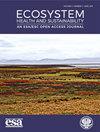山区生态系统的热浪缓解——以长江上游流域为例
IF 3.4
2区 环境科学与生态学
Q1 ECOLOGY
引用次数: 2
摘要
摘要背景森林和草原等自然生态系统可以缓解热浪,但对山地生态系统中的热浪缓解研究较少。以长江上游流域为研究区域,基于数字高程模型(DEM),将长江上游流域划分为山区和非山区。然后,我们使用温度来识别热浪,并使用温度和湿度指数来识别合适的天数。最后,比较了山区与非山区的差异,提出了区域发展战略。结果(1)1986年至2015年,热浪的频率和持续时间分别增加了0.433次/年(P<0.1)、0.07次/天(P<0.05),而6月、7月和8月的适宜天数分别略有减少,分别减少了0.0096次/天、0.0125次/天和0.004次/天。(2) 1986年至2015年夏季,山区的月平均适宜天数最高。由于当地气候的地形变化,山区在缓解热浪方面具有优势。(3) 除地形外,海拔是缓解山区热浪的主要因素。结论根据1986~2015年夏季适宜天数,高原部分地区和整个山区最适合避免极端高温。我们建议制定旅游促进战略,加强旅游基础设施建设,考虑景观保护和创造,以促进区域可持续发展。本文章由计算机程序翻译,如有差异,请以英文原文为准。
Heat wave mitigation of ecosystems in mountain areas — a case study of the Upper Yangtze River basin
ABSTRACT Background Natural ecosystems, such as forests and grasslands, can mitigate heat waves, but research on heat wave mitigation in mountain ecosystems is lacking. Considering the upper reaches of the Yangtze River basin (URYB) as the study area, we first divided the URYB into mountainous and non-mountainous areas based on a digital elevation model (DEM). Then, we used temperature to identify heat waves and used the temperature and humidity index to identify suitable days. Finally, the differences between mountainous and non-mountainous areas were compared, and regional development strategies are proposed. Result (1)The frequency and duration of heat waves increased by 0.433/y (P < 0.1), 0.07/y (P < 0.05), while the number of suitable days in June, July, and August gradually decreased slightly by 0.0096/y (P < 0.1), 0.0125/y (P < 0.1), 0.004/y (P < 0.1), respectively from 1986 to 2015. (2)The average monthly number of suitable days was the highest in mountainous areas during the summer from 1986 to 2015. Mountainous areas have an advantage in mitigating heat waves owing to landform-based changes in the local climate. (3)In addition to the landform, altitude was the main factor responsible for mitigating heat waves in mountainous areas. Conclusion Parts of the plateau and whole mountain areas were found to be best for avoiding extremely high temperatures based on the number of suitable summer days from 1986 to 2015. We suggest formulating tourism promotion strategies, and strengthening tourism infrastructure, considering landscape protection and creation to promote sustainable regional development.
求助全文
通过发布文献求助,成功后即可免费获取论文全文。
去求助
来源期刊

Ecosystem Health and Sustainability
Environmental Science-Management, Monitoring, Policy and Law
CiteScore
7.10
自引率
2.00%
发文量
40
审稿时长
22 weeks
期刊介绍:
Ecosystem Health and Sustainability publishes articles on advances in ecology and sustainability science, how global environmental change affects ecosystem health, how changes in human activities affect ecosystem conditions, and system-based approaches for applying ecological science in decision-making to promote sustainable development. Papers focus on applying ecological theory, principles, and concepts to support sustainable development, especially in regions undergoing rapid environmental change. Papers on multi-scale, integrative, and interdisciplinary studies, and on international collaborations between scientists from industrialized and industrializing countries are especially welcome.
Suitable topics for EHS include:
• Global, regional and local studies of international significance
• Impact of global or regional environmental change on natural ecosystems
• Interdisciplinary research involving integration of natural, social, and behavioral sciences
• Science and policy that promote the use of ecological sciences in decision making
• Novel or multidisciplinary approaches for solving complex ecological problems
• Multi-scale and long-term observations of ecosystem evolution
• Development of novel systems approaches or modeling and simulation techniques
• Rapid responses to emerging ecological issues.
 求助内容:
求助内容: 应助结果提醒方式:
应助结果提醒方式:


